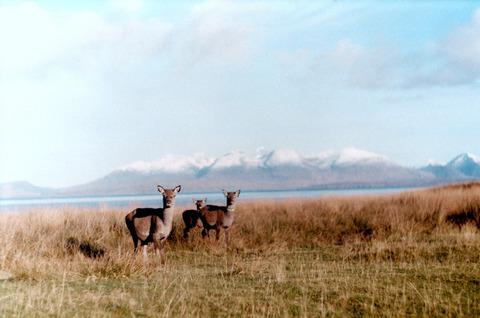当前位置:
X-MOL 学术
›
Funct. Ecol.
›
论文详情
Our official English website, www.x-mol.net, welcomes your
feedback! (Note: you will need to create a separate account there.)
Reproduction has different costs for immunity and parasitism in a wild mammal
Functional Ecology ( IF 4.6 ) Pub Date : 2019-11-15 , DOI: 10.1111/1365-2435.13475 Gregory F. Albery 1 , Kathryn A. Watt 1 , Rosie Keith 1 , Sean Morris 1 , Alison Morris 1 , Fiona Kenyon 2 , Daniel H. Nussey 1 , Josephine M. Pemberton 1
Functional Ecology ( IF 4.6 ) Pub Date : 2019-11-15 , DOI: 10.1111/1365-2435.13475 Gregory F. Albery 1 , Kathryn A. Watt 1 , Rosie Keith 1 , Sean Morris 1 , Alison Morris 1 , Fiona Kenyon 2 , Daniel H. Nussey 1 , Josephine M. Pemberton 1
Affiliation

|
Life history theory predicts that reproductive allocation draws resources away from immunity, resulting in increased parasitism. However, studies of reproductive trade‐offs rarely examine multiple measures of reproduction, immunity and parasitism. It is therefore unclear whether the immune costs of reproductive traits correlate with their resource costs, and whether increased parasitism emerges from weaker immunity. We examined these relationships in wild female red deer (Cervus elaphus) with variable reproductive allocation and longitudinal data on mucosal antibody levels and helminth parasitism. We noninvasively collected faecal samples, counting propagules of strongyle nematodes (order: Strongylida), the common liver fluke Fasciola hepatica and the red deer tissue nematode Elaphostrongylus cervi. We also quantified both total and anti‐strongyle mucosal IgA to measure general and specific immune allocation. Contrary to our predictions, we found that gestation was associated with decreased total IgA but with no increase in parasitism. Meanwhile, the considerable resource demand of lactation had no further immune cost but was associated with higher counts of strongyle nematodes and E. cervi. These contrasting costs arose despite a negative correlation between antibodies and strongyle count, which implied that IgA was indicative of protective immunity. Our findings suggest that processes other than classical resource allocation trade‐offs are involved in mediating observed relationships between reproduction, immunity and parasitism in wild mammals. In particular, reproduction–immunity trade‐offs may result from hormonal regulation or maternal antibody transfer, with parasitism increasing as a result of increased exposure arising from resource acquisition constraints. We advocate careful consideration of resource‐independent mechanistic links and measurement of both immunity and parasitism when investigating reproductive costs. A free Plain Language Summary can be found within the Supporting Information of this article.
中文翻译:

繁殖对野生哺乳动物的免疫和寄生具有不同的成本
生活史理论预测,生殖分配会从免疫中吸取资源,导致寄生虫增加。然而,生殖权衡的研究很少考察生殖、免疫和寄生的多种衡量标准。因此,尚不清楚生殖性状的免疫成本是否与其资源成本相关,以及寄生性增加是否源于免疫力较弱。我们用可变的生殖分配和粘膜抗体水平和蠕虫寄生的纵向数据检查了野生雌性马鹿(Cervus elaphus)的这些关系。我们非侵入性地收集了粪便样本,计算了圆线虫线虫(顺序:圆线虫)、常见的肝吸虫肝吸虫和马鹿组织线虫 Elaphostrongylus cervi 的繁殖体。我们还量化了总和抗圆线虫粘膜 IgA,以测量一般和特异性免疫分配。与我们的预测相反,我们发现妊娠与总 IgA 减少有关,但没有增加寄生。同时,哺乳期的大量资源需求没有进一步的免疫成本,但与圆线虫和 E. cervi 的数量增加有关。尽管抗体和金圆线虫计数之间呈负相关,但这些对比成本还是出现了,这意味着 IgA 是保护性免疫的指标。我们的研究结果表明,除了经典的资源分配权衡之外,还涉及调节野生哺乳动物繁殖、免疫和寄生之间观察到的关系。特别是,生殖-免疫权衡可能来自激素调节或母源抗体转移,由于资源获取限制导致暴露增加,寄生虫增加。我们提倡在调查生殖成本时仔细考虑与资源无关的机制联系以及免疫和寄生的测量。可以在本文的支持信息中找到免费的普通语言摘要。
更新日期:2019-11-15
中文翻译:

繁殖对野生哺乳动物的免疫和寄生具有不同的成本
生活史理论预测,生殖分配会从免疫中吸取资源,导致寄生虫增加。然而,生殖权衡的研究很少考察生殖、免疫和寄生的多种衡量标准。因此,尚不清楚生殖性状的免疫成本是否与其资源成本相关,以及寄生性增加是否源于免疫力较弱。我们用可变的生殖分配和粘膜抗体水平和蠕虫寄生的纵向数据检查了野生雌性马鹿(Cervus elaphus)的这些关系。我们非侵入性地收集了粪便样本,计算了圆线虫线虫(顺序:圆线虫)、常见的肝吸虫肝吸虫和马鹿组织线虫 Elaphostrongylus cervi 的繁殖体。我们还量化了总和抗圆线虫粘膜 IgA,以测量一般和特异性免疫分配。与我们的预测相反,我们发现妊娠与总 IgA 减少有关,但没有增加寄生。同时,哺乳期的大量资源需求没有进一步的免疫成本,但与圆线虫和 E. cervi 的数量增加有关。尽管抗体和金圆线虫计数之间呈负相关,但这些对比成本还是出现了,这意味着 IgA 是保护性免疫的指标。我们的研究结果表明,除了经典的资源分配权衡之外,还涉及调节野生哺乳动物繁殖、免疫和寄生之间观察到的关系。特别是,生殖-免疫权衡可能来自激素调节或母源抗体转移,由于资源获取限制导致暴露增加,寄生虫增加。我们提倡在调查生殖成本时仔细考虑与资源无关的机制联系以及免疫和寄生的测量。可以在本文的支持信息中找到免费的普通语言摘要。











































 京公网安备 11010802027423号
京公网安备 11010802027423号